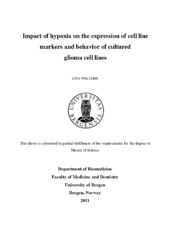| dc.description.abstract | Glioblastoma multiforme (GBM) constitute over 50 % of primary brain tumors in adults. The tumor is heterogeneous and highly infiltrative. Its nature makes it extremely aggressive and incurable. Thus, today's treatment modalities only have a palliative function and provide a modest survival benefit. This states the need for further research to reveal the biological mechanisms behind GBM development. The name glioblastoma multiforme reflects the expression of markers of many different CNS cell lineages in this tumor. Notably, GBMs have been reported to comprise cells that express stem cell markers, and it is postulated that glioma stem cells is the cell type initiating and maintaining this tumor. Also, several lines of evidence strongly suggest that hypoxia is a cancer stem cell niche. Furthermore, hypoxia is associated with poor prognosis in many solid cancers, being implicated in induction of radio- and chemoresistance and in tumor invasion. Hence, hypoxia and cancer stem cells may be two factors that contribute to the failure to treat this tumor. They might therefore be candidates which can be targeted in new therapeutical strategies for GBM. To assess the expression of cancer stem cell markers in hypoxia, five glioma cell lines were cultured for various time periods in normoxic (21 %) and hypoxic (0.5 and 2 %) conditions. Expression of a panel of cell lineage markers was investigated in the different oxygen conditions. Additionally, cell behavior in hypoxia compared to normoxia was evaluated by investigating proliferation, migration and apoptosis. We found that none of the stem cell markers that we looked at were upregulated in hypoxia, which is contradictory to previous reports. Instead, these stem cell markers and the astrocytic marker GFAP were all downregulated. Furthermore, cell proliferation and migration both decreased in hypoxia. This points at an overall slow down of the glioma cell machinery in hypoxia. Other studies have mainly been performed on small selections of biopsy material cultured in serum free medium, and this approach should be included in the present study in the future. | en_US |
